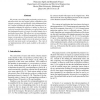Free Online Productivity Tools
i2Speak
i2Symbol
i2OCR
iTex2Img
iWeb2Print
iWeb2Shot
i2Type
iPdf2Split
iPdf2Merge
i2Bopomofo
i2Arabic
i2Style
i2Image
i2PDF
iLatex2Rtf
Sci2ools
CVPR
1999
IEEE
1999
IEEE
Projective Rectification Without Epipolar Geometry
We present a novel algorithm performing projective rectification which does not require explicit computation of the epipolar geometry, and specifically of the fundamental matrix. Instead of finding the epipoles and computing two homographies mapping the epipoles to infinity, as done in recent work on projective rectification, we exploit the fact that the fundamental matrix of a pair of rectified images has a particular, known form. This allows us to set up a minimization that yields the rectifying homographies directly from image correspondences. Experimental results show that our method works quite robustly even in the presence of noise, and with inaccurate point correspondences. The code of our implementation will be made available at the author's web site.
Computer Vision | CVPR 1999 | Fundamental Matrix | Inaccurate Point Correspondences | Projective Rectification |
| Added | 02 Aug 2010 |
| Updated | 02 Aug 2010 |
| Type | Conference |
| Year | 1999 |
| Where | CVPR |
| Authors | Francesco Isgrò, Emanuele Trucco |
Comments (0)

